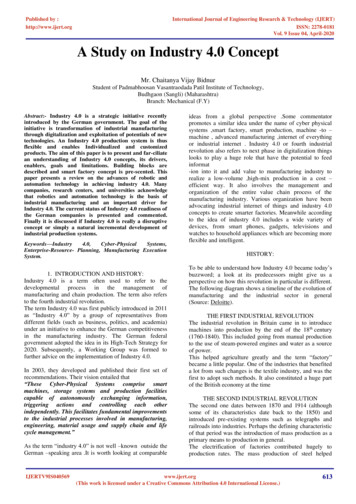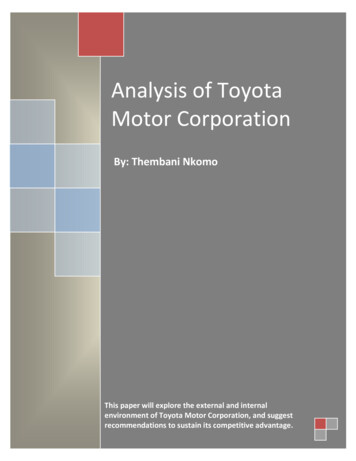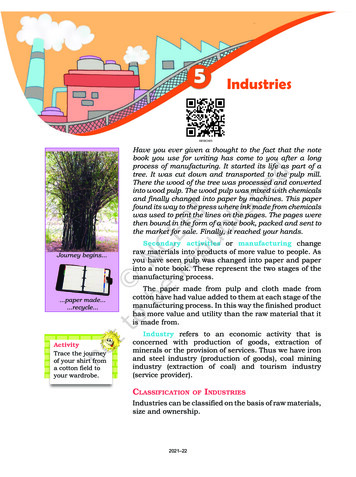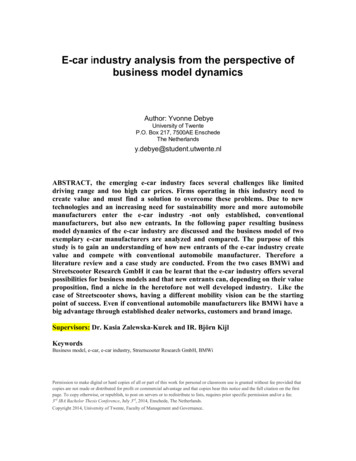
Transcription
Published by :http://www.ijert.orgInternational Journal of Engineering Research & Technology (IJERT)ISSN: 2278-0181Vol. 9 Issue 04, April-2020A Study on Industry 4.0 ConceptMr. Chaitanya Vijay BidnurStudent of Padmabhoosan Vasantraodada Patil Institute of Technology,Budhgaon (Sangli) (Maharashtra)Branch: Mechanical (F.Y)Abstract:- Industry 4.0 is a strategic initiative recentlyintroduced by the German government. The goal of theinitiative is transformation of industrial manufacturingthrough digitalization and exploitation of potentials of newtechnologies. An Industry 4.0 production system is thusflexible and enables Individualized and customizedproducts. The aim of this paper is to present and far-ciliatean understanding of Industry 4.0 concepts, its drivers,enablers, goals and limitations. Building blocks aredescribed and smart factory concept is pre-scented. Thispaper presents a review on the advances of robotic andautomation technology in achieving industry 4.0. Manycompanies, research centers, and universities acknowledgethat robotics and automation technology is the basis ofindustrial manufacturing and an important driver forIndustry 4.0. The current status of Industry 4.0 readiness ofthe German companies is presented and commented.Finally it is discussed if Industry 4.0 is really a disruptiveconcept or simply a natural incremental development ofindustrial production ms,Enterprise-Resource- Planning, Manufacturing ExecutionSystem.1. INTRODUCTION AND HISTORY:Industry 4.0 is a term often used to refer to thedevelopmental process in the management ofmanufacturing and chain production. The term also refersto the fourth industrial revolution.The term Industry 4.0 was first publicly introduced in 2011as “Industry 4.0” by a group of representatives fromdifferent fields (such as business, politics, and academia)under an initiative to enhance the German competitivenessin the manufacturing industry. The German federalgovernment adopted the idea in its High-Tech Strategy for2020. Subsequently, a Working Group was formed tofurther advice on the implementation of Industry 4.0.In 2003, they developed and published their first set ofrecommendations. Their vision entailed that“These Cyber-Physical Systems comprise smartmachines, storage systems and production facilitiescapable of autonomously exchanging information,triggering actions and controlling each otherindependently. This facilitates fundamental improvementsto the industrial processes involved in manufacturing,engineering, material usage and supply chain and lifecycle management.”As the term “industry 4.0” is not well –known outside theGerman –speaking area .It is worth looking at comparableIJERTV9IS040569ideas from a global perspective .Some commentatorpromotes a similar idea under the name of cyber physicalsystems ,smart factory, smart production, machine -to –machine , advanced manufacturing ,internet of everythingor industrial internet . Industry 4.0 or fourth industrialrevolution also refers to next phase in digitalization thingslooks to play a huge role that have the potential to feedinformat-ion into it and add value to manufacturing industry torealize a low-volume ,high-mix production in a cost –efficient way. It also involves the management andorganization of the entire value chain process of themanufacturing industry. Various organization have beenadvocating industrial internet of things and industry 4.0concepts to create smarter factories. Meanwhile accordingto the idea of industry 4.0 includes a wide variety ofdevices, from smart phones, gadgets, televisions andwatches to household appliances which are becoming moreflexible and intelligent.HISTORY:To be able to understand how Industry 4.0 became today’sbuzzword; a look at its predecessors might give us aperspective on how this revolution in particular is different.The following diagram shows a timeline of the evolution ofmanufacturing and the industrial sector in general(Source: Deloitte).THE FIRST INDUSTRIAL REVOLUTIONThe industrial revolution in Britain came in to introducemachines into production by the end of the 18 th century(1760-1840). This included going from manual productionto the use of steam-powered engines and water as a sourceof power.This helped agriculture greatly and the term “factory”became a little popular. One of the industries that benefiteda lot from such changes is the textile industry, and was thefirst to adopt such methods. It also constituted a huge partof the British economy at the timeTHE SECOND INDUSTRIAL REVOLUTIONThe second one dates between 1870 and 1914 (althoughsome of its characteristics date back to the 1850) andintroduced pre-existing systems such as telegraphs andrailroads into industries. Perhaps the defining characteristicof that period was the introduction of mass production as aprimary means to production in general.The electrification of factories contributed hugely toproduction rates. The mass production of steel helpedwww.ijert.org(This work is licensed under a Creative Commons Attribution 4.0 International License.)613
Published by :http://www.ijert.orgInternational Journal of Engineering Research & Technology (IJERT)ISSN: 2278-0181Vol. 9 Issue 04, April-2020introduce railways into the system, which consequentlycontributed to mass production. Innovations in chemistry,such as the invention of the synthetic dye, also mark suchperiod as chemistry was in a rather primitive state then.However, such revolutionary approaches to industry wereput to an end with the start of World War I. Massproduction, of course, was not put to an end, but onlydevelopments within the same context were made and noneof which can be called industrial revolutions.THE THIRD INDUSTRIAL REVOLUTIONPerhaps the third one is much more familiar to us than therest as most people living today are familiar with industriesleaning on digital technologies in production. However, thethird industrial revolution is dated between 1950 and 1970.It is often referred to as the Digital Revolution, and cameabout the change from analog and mechanical systems todigital ones.Others call it the Information Age too. The third revolutionwas, and still is, a direct result of the huge development incomputers and information and communicationtechnology.IMPORTANCE & SCOPE OF TECHNOLOGY ININDUSTRY 4.0:Before diving into all the mentioned evolutions,integrations, cyber-physical evolutions, IoT elements, bigdata aspects and before looking at the origins of Industry4.0, definitions, evolutions, global implications, similarinitiatives, Industry 4.0 design principles, building blocksand the Reference Architecture Model Industry 4.0 a finalword on technologies and people to wrap up this quickintroduction.It is important to note that Industry 4.0 is not just aboutthose technologies. It also looks at the impact on and roleof society and workers (e.g. collaboration between manand machine as with collaborative robots or cobots, newrequired skillsets of workers in industries amidst all thesechanges and, inevitably, the loss of jobs due to ongoingautomation as mentioned – and how to tackle this majorchallenge).Moreover, Industry 4.0 also has a strong focus on security.This does not just mean security of data andcommunicationnetworks,dataprotection (including personal data protection, especiallysince the arrival of the General Data ProtectionRegulation, the ePrivacy Regulation and coming rules inseveral areas, including green facilities, energy andecology, and again personal data in the wake of scandalsthat have emerged in consumer markets), cybersecurity inthe broadest sense and industrial control systemssecurity (ICS security) but also the protection and securityof workers, industrial assets, critical infrastructure and‘physical security’.IJERTV9IS040569As industrial assets and critical infrastructure (from criticalpower buildings to energy grids and more) get connectedand attacks are on the rise in the traditionally ratherisolated industrial environments the stakes and dangers ofvulnerabilities and attacks are huge in industry 4.0 whichrequires an end-to-end ‘security by design’ approach.This overall security challenge and certainly the ICSsecurity and end-to-end cybersecurity challenge ranks highamong the Industry 4.0 challenges and risks.On an Industry 4.0 technology level, finally, on top of thementionedtechnologies (orrathergroupsoftechnologies) such as IoT, big data, IT, OT, severalsecurity technologies (industrial cybersecurity, visualmonitoring of critical facilities, wearables to monitorworker safety in hazardous environments), artificialintelligence (AI), cloud, edge, fog and more you canadd: additive manufacturing and 3D printing, digitaltwins, virtual and augmented reality (also in the contextof digital twin simulation), advanced robotics and cobots,autonomous production, rapid application development,autonomous production, consistent engineering across theentire value chain, thorough data collection andprovisioning, systems integration (cfr. vertical andhorizontal integration), a vast range of networking andcommunication technologies, integration and connectivitystandards/protocols, ways to make various IT and OTprotocols interoperable and far more on the horizon, suchas blockchain and technologies to not just meet demandsfor more bandwidth but also to power connected devices.On the technological front it’s important to look at thetechnologies underneath terms such as IoT but also to lookat how it all connects, especially as on this technologylevel (where data and how you leverage, protect, exchange,enrich and even monetize it is at the center as you can seein the above list) the keyword is integration as well: fromthe integration of IT and OT to the integration of IoT andAI; big data, IoT and AI; blockchain and IoT.New Industry 4.0 technologies, spanning mobilecomputing to cloud computing, have undergone vastdevelopment in the last decade and are now ready to beused as commercially available, interconnected systemswithin manufacturing – this is Industry 4.0. It holds the keyto accessing real-time results and data that will catapult theindustry into new levels of lean achievements.The concept of Industry 4.0 however, is not a simple one. Itenvelops many technologies and is used in a variety ofdifferent contexts. There are five pieces that defineIndustry 4.0 at its core. Each piece is similar in nature but,when integrated together, create capability that has neverbefore been possible. In an effort to understand Industry4.0, the following five terms are explained as theycontribute to the next industrial revolution:www.ijert.org(This work is licensed under a Creative Commons Attribution 4.0 International License.)614
Published by :http://www.ijert.orgInternational Journal of Engineering Research & Technology (IJERT)ISSN: 2278-0181Vol. 9 Issue 04, April-20201. Big DataPhoto credit: innovation-awards.nlAs per Forbes, Big Data is a collection of data fromtraditional and digital sources inside and outside yourcompany that represents a source for ongoing discoveryand analysis. Today data is collected everywhere, fromsystems and sensors to mobile devices. The challenge isthat the industry is still in the process of developingmethods to best interpret data. It’s the evolution of Industry4.0 that will change the way organizations and solutionswithin those organizations work together; teams will beable to make better, smarter decisions.2. SMART FACTORY:The concept of Smart Factory is the seamless connection ofindividual production steps, from planning stages toactuators in the field. In the near future, machinery andequipment will be able to improve processes through selfoptimization; systems will autonomously adapt to thetraffic profile and network environment. AutonomousMobile Robots (AMRs) are an integral part of the SmartFactory, as their autonomous intelligence connects thefactory together, allowing seamless operations.Leading by example is the Siemens Electronic Worksfacility in Amberg, Germany. Smart machines coordinateproduction and global distribution or a built-to-orderprocess involving roughly 1.6 billion components. Whenthe Smart Factory is achieved, it will represent a pivotalshift for Industry 4.0, as the revolution will begin to roll outacross multiple verticals. Various markets spanninghealthcare to consumer goods will adapt Industry 4.0technologies initially modelled in the Smart Factory.Photo credit: https://www.siemens.com/press/.3. CYBER PHYSICAL SYSTEMSCyber physical systems are integrations of computation,networking and physical processes. Computers andnetworks monitor and control physical processes withfeedback loops; the physical system reacts; the system usesIJERTV9IS040569software to interpret actions and tracks results. The notioncenters on computers and software being embedded indevices where the first use is not computation; rather it is aloop of action and machine learning.www.ijert.org(This work is licensed under a Creative Commons Attribution 4.0 International License.)615
Published by :http://www.ijert.orgInternational Journal of Engineering Research & Technology (IJERT)ISSN: 2278-0181Vol. 9 Issue 04, April-20204. INTERNET OF THINGS (IOT)Photo credit: i-scoop.euThe internet of things is a simple term for a grandioseconcept. IoT is the connection of all devices to the internetand each other. As Wired said, “it’s built on cloudcomputing and networks of data-gather sensors;it’s mobile, virtual, and instantaneous connection.” Thisinterconnection will enable “smart factories” to take shapeas equipment will use data to manufacture, move, andreport and learn at astounding rates, efficiently.IMPORTANCE & SCOPE OF TECHNOLOGY ININDUSTRY 4.0:Before diving into all the mentioned evolutions,integrations, cyber-physical evolutions, IoT elements, bigdata aspects and before looking at the origins of Industry4.0, definitions, evolutions, global implications, similarinitiatives, Industry 4.0 design principles, building blocksand the Reference Architecture Model Industry 4.0 a finalword on technologies and people to wrap up this quickintroduction.It is important to note that Industry 4.0 is not just aboutthose technologies. It also looks at the impact on and roleof society and workers (e.g. collaboration between manand machine as with collaborative robots or cobots, newrequired skillsets of workers in industries amidst all thesechanges and, inevitably, the loss of jobs due to ongoingautomation as mentioned – and how to tackle this majorchallenge).Moreover, Industry 4.0 also has a strong focus on security.This does not just mean security of data andcommunicationnetworks,dataprotection (including personal data protection, especiallysince the arrival of the General Data ProtectionRegulation, the ePrivacy Regulation and coming rules inseveral areas, including green facilities, energy andecology, and again personal data in the wake of scandalsthat have emerged in consumer markets), cybersecurity inIJERTV9IS040569the broadest sense and industrial control systemssecurity (ICS security) but also the protection and securityof workers, industrial assets, critical infrastructure and‘physical security’.As industrial assets and critical infrastructure (from criticalpower buildings to energy grids and more) get connectedand attacks are on the rise in the traditionally ratherisolated industrial environments the stakes and dangers ofvulnerabilities and attacks are huge in industry 4.0 whichrequires an end-to-end ‘security by design’ approach.This overall security challenge and certainly the ICSsecurity and end-to-end cybersecurity challenge ranks highamong the Industry 4.0 challenges and risks.On an Industry 4.0 technology level, finally, on top of thementionedtechnologies (orrathergroupsoftechnologies) such as IoT, big data, IT, OT, severalsecurity technologies (industrial cybersecurity, visualmonitoring of critical facilities, wearables to monitorworker safety in hazardous environments), artificialintelligence (AI), cloud, edge, fog and more you canadd: additive manufacturing and 3D printing, digitaltwins, virtual and augmented reality (also in the contextof digital twin simulation), advanced robotics and cobots,autonomous production, rapid application development,autonomous production, consistent engineering across theentire value chain, thorough data collection andprovisioning, systems integration (cfr. vertical andhorizontal integration), a vast range of networking andcommunication technologies, integration and connectivitystandards/protocols, ways to make various IT and OTprotocols interoperable and far more on the horizon, suchas blockchain and technologies to not just meet demandsfor more bandwidth but also to power connected devices.On the technological front it’s important to look at thetechnologies underneath terms such as IoT but also to lookat how it all connects, especially as on this technologylevel (where data and how you leverage, protect, exchange,enrich and even monetize it is at the center as you can seein the above list) the keyword is integration as well: fromwww.ijert.org(This work is licensed under a Creative Commons Attribution 4.0 International License.)616
Published by :http://www.ijert.orgInternational Journal of Engineering Research & Technology (IJERT)ISSN: 2278-0181Vol. 9 Issue 04, April-2020the integration of IT and OT to the integration of IoT andAI; big data, IoT and AI; blockchain and IoT.INDUSTRIAL ROBOTIC POTENTIAL IN INDIA:Sales of industrial robots in India reached a new record of4,771 new units installed in 2018. That is an increase of39% compared to the previous year (2017: 3,412 units).India now ranks eleventh worldwide in terms of annualinstallations. These are the findings of the report WorldRobotics 2019, presented by the International Federation ofRobotics (IFR).“India is one of the strongest growing economies amongthe emerging markets in Asia,” says Junji Tsuda, Presidentof the International Federation of Robotics. “Whilst therecent global results were quite moderate, India saw animpressive growth rate of 39% in 2018. The number ofrobot installations has been growing rapidly for severalyears now. Between 2013 and 2018, India saw a compoundannual growth rate of 20%.”Prospects for further increasing robot installations arepromising. The Indian GDP is expected to grow by morethan 7% in 2019 and companies across many industriesintend to expand capacities. India has a young population,hence a strong workforce in need of jobs.The country needs to expand its manufacturing industry tocreate more job opportunities. Higher wages and the risingshare of affluent citizens in India are the main drivers of agrowing and promising consumer market. The automotiveindustry remains the largest customer industry by far, witha share of 44% of total installations. But the strongestgrowth driver in 2018 was the general industry, increasingby 28%, consisting of the rubber and plastics industry, themetal industry and the electrical/electronics industry. Robotuse in non-automotive manufacturing is catching up withthe automotive sector.India now ranks eleventh in the global annual supply –three places higher compared to the previous year andahead of Singapore, Canada and Thailand. The operationalstock of robots rose to about 23,000 units: 21% comparedto 2017. The country’s automation potential is illustratedby a low robot density figure in the automotive industry: 99industrial robots per 10,000 employees is less than a fourthof Indonesia’s density (440 units) and far away from China(732 units) and the frontrunner Korea (2,589).CURRENT STATE OF INDUSTRY 4.0 IN INDIAIndia has to move from manufacturing outfits of Industry1.0 and 2.0 to Industry 4.0 and beyond. EEPC India inassociation of Department of Heavy industries (DHI) israising awareness on the 4th Industrial Revolution to drivethe Indian manufacturing to a ‘Smart and intelligentManufacturing’ Hub said Mr. Ravi Sehgal at a Industry 4.0session .Smart Advanced Manufacturing and Rapid TransformationHub (SAMARTH) - Udyog Bharat 4.0 is an Industry 4.0initiative of Department of Heavy Industry, Government ofIndia under its scheme on Enhancement ofCompetitiveness in Indian Capital Goods Sector. Theinitiative aims to raise awareness about Industry 4.0 amongthe Indian manufacturing industry through demonstrationIJERTV9IS040569centres. Currently there are four centres which includeCenter for Industry 4.0 (C4i4) Lab Pune; IITD-AIAFoundation for Smart Manufacturing; I4.0 India at IIScFactory R & D Platform; Smart Manufacturing Demo &Development Cell at CMTI.Indian Engineering Exports have been growing at a rate of10% with variation, but the Engineering Exports as apercentage of ASEAN and World Exports is stagnating at0.8-1 % over the last 10-15 years. This is because majorityof engineering goods originated from low or middle levelproducts. Department of Commerce, Ministry ofCommerce and Industry has given to this apex engineeringbody a mandate to incarnate a Technology Centre to enableMSMEs to benefit from various new technologies. Indiaalso needs to close a quality gap faced with the best inclass, and leapfrogging to newer technologies, will enablequality export products, hence EEPC India TechnologyCentre gains ground.EEPC India Technology Centre in Bengaluru and also theone would be opened shortly in Kolkata , with a view todevelop export product by providing a forum for Industryand Academia discussion and learning'' Mr. Sehgal said atthe seminar. It was a day long productive session whereeminent speakers from DHI, IIT Kharagpur, ISI-Kolkata;CMERI- Durgapur; CMTI, C4i4 Pune motivated thestakeholders on the themeIn its pursuit to foster best-in-class manufacturinginfrastructure in India, the “Make in India” initiative isspearheading wider adoption of ‘Industry 4.0’, the newbuzzword for the combination of industry and the currentInternet of Things (IoT) technology, in the country.Banking on India’s strength in Information Technology anda large workforce of IT professionals, the transformativejourney of manufacturing through Industry 4.0 has alreadybegun in the country. Under the Government of India’s‘Smart Cities Mission’, the projects to build 100 smartcities across India are being touted as the forerunners of theIndustry 4.0 environment.1Additionally, the Indian Institute of Science (IISc) isbuilding India’s first smart factory in Bengaluru with aseed funding from the Boeing Company.2 Bosch, a Germanauto component manufacturer will begin implementation ofsmart manufacturing at its 15 centres in India by2018.3 General Electric has invested USD 200 million inthe facility in its only multi-modal factory in India wheredigitally interlinked supply chains, distribution networks,and servicing units form part of this intelligent ecosystem.With rapid development in the fields of informationtechnology and hardware, the world is about to witness afourth industrial revolution.4 the concept of ‘Industry 4.0’is going to change the way India manufactures, designs andrefurbishes the products. Driven by the power of big data,high computing capacity, artificial intelligence andanalytics, Industry 4.0 aims to completely digitize themanufacturing sector.www.ijert.org(This work is licensed under a Creative Commons Attribution 4.0 International License.)617
Published by :http://www.ijert.orgInternational Journal of Engineering Research & Technology (IJERT)ISSN: 2278-0181Vol. 9 Issue 04, April-2020CONCLUSION:In this paper, the background and development ofthe Industry 4.0 concept are presented. Although theconcept is very comprehensive and complex, threemain points can be identified: The Industry 4.0 concept is not limited justto the direct manufacturing in the company but itincludes also a complete value chain from providersto customers and all enterprise’s business functionsand services The Industry 4.0 assumes broad support ofan entire life cycle of systems, products and series,distributed both spatially and organizationally. Thesmart products are not smart only during themanufacturing process but they continue to providethe data about their state also during their lifetime.These data can be used for preventive maintenance; itcan provide the manufacturer useful informationabout lifetime and reliability of their products. The Industry 4.0 is a specialization of trial environment. It assumes areal-time data collection leading to the issue ofhandling and analysing huge data and cybersecurity.Industry 4.0 is new industrial revolution of the 21 stcentury, which enables companies to create “smarter”products and services by reducing costs and increasingefficiency, where the human factor is crucial for theapplication and the work is based on the existingliterature in the area.Smart Factory makes a solution which, due to thesystem’s automated procedures, uncomplicated setupincluding simple, need-based installation and ultimately,high degree of scalability, can help companies in themanufacturing sector further optimize their processesand significantly boost their internal efficiency.Five million workplaces could be lost due todigitalization in major industrialized nations. Also, itwill quickly stop the market demand for the productsmade with outdated technologies due to lack of qualityand such production would have to be shut down due tohigh costs and inefficiency.REFERENCES:Research paper and DUSTRIALAUTOMATION AND ROBOTICAuthor: Mohd Arman kamarul bahrin, Mohd Fauzi orthman, norhayati azli, Muhamad farihan talibhttps://www.researchgate.net/profile/Fauzi Othman/publication/304614356 Industry 40 A review on industrial automation and OCUSPAPERINDUSTRY4.0CONCEPT:BACKGROUND AND OVERVIEWAUTHOR: ANDREJA 1107 Industry40 the Future Concepts and New Visions of Factory ofthe Future 41.cms?from mdrhttps://en.wikipedia.org/wiki/Industrial ki/Industry 4.0Finally as Mr. Warren G. Bennis said:“The factory of the future will have two employees; ahuman and a dog. The task of the human will be to feedthe dog. The dog will have the task to dissuade thehuman to touch the automated systems.”IJERTV9IS040569www.ijert.org(This work is licensed under a Creative Commons Attribution 4.0 International License.)618
Industry 4.0 is a term often used to refer to the developmental process in the management of manufacturing and chain production. The term also refers to the fourth industrial revolution. The term Industry 4.0 was first publicly introduced in 2011 as “Indu











